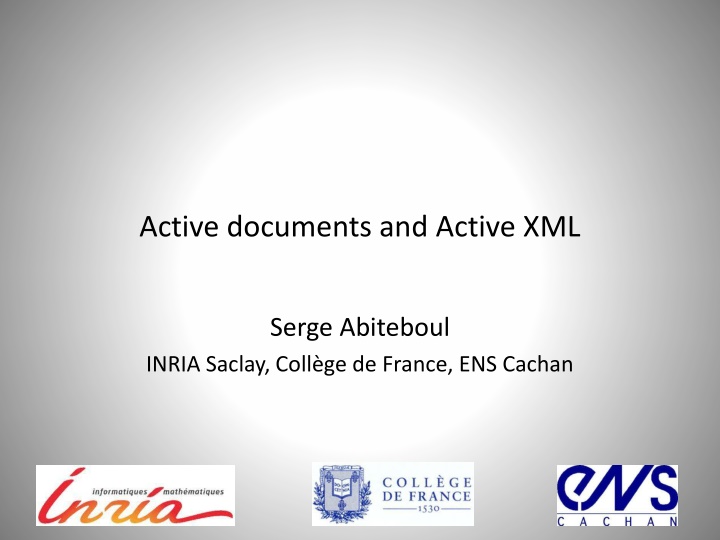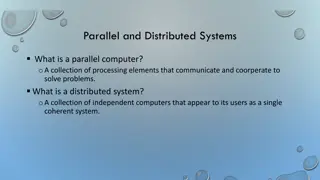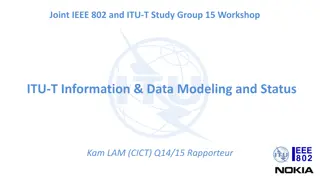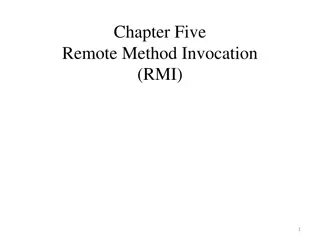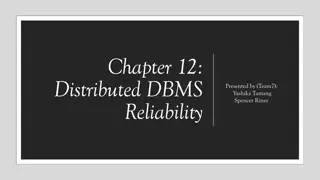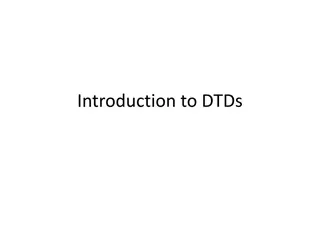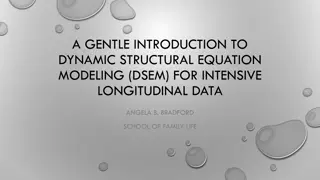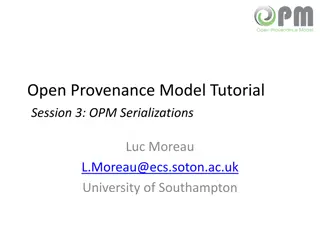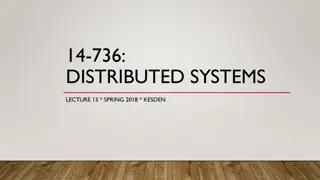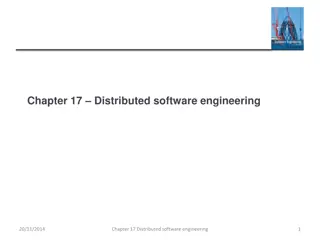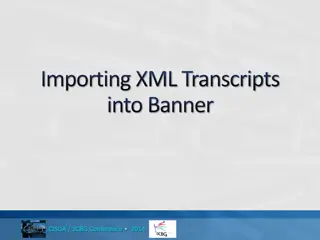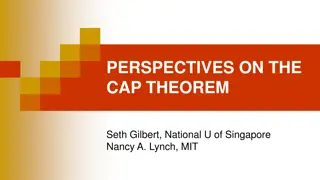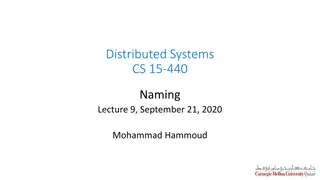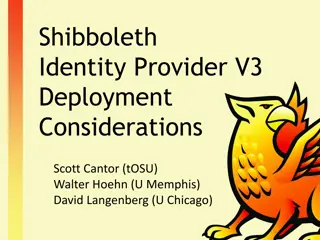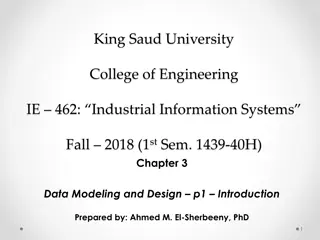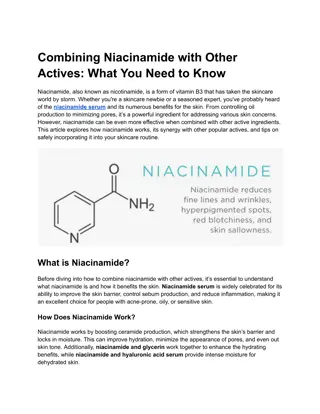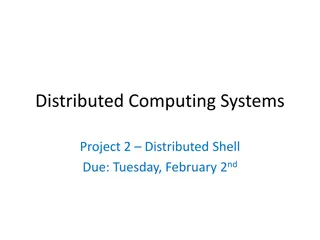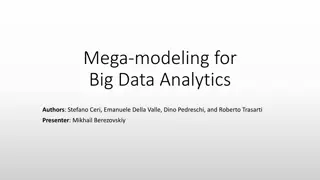Active Documents and Active XML: Modeling Data-Intensive Distributed Systems
Explore the world of active documents and Active XML in managing data-intensive distributed systems. Dive into topics such as query optimization, monitoring, task sequencing, and more. Discover the importance of modeling, optimization, and monitoring in this evolving landscape. Uncover key concepts, roadmaps, and lessons from the past to enhance your understanding of web data management and distribution.
Download Presentation

Please find below an Image/Link to download the presentation.
The content on the website is provided AS IS for your information and personal use only. It may not be sold, licensed, or shared on other websites without obtaining consent from the author.If you encounter any issues during the download, it is possible that the publisher has removed the file from their server.
You are allowed to download the files provided on this website for personal or commercial use, subject to the condition that they are used lawfully. All files are the property of their respective owners.
The content on the website is provided AS IS for your information and personal use only. It may not be sold, licensed, or shared on other websites without obtaining consent from the author.
E N D
Presentation Transcript
Active documents and Active XML Serge Abiteboul INRIA Saclay, Coll ge de France, ENS Cachan 9/30/2024 9/30/2024 1 1
Organization Introduction Modeling data intensive distributed systems Query optimization in distributed systems Monitoring in distributed systems Task sequencing in distributed systems Conclusion 2
Context: Web data management Scale: lots of servers, large volume of data Servers are autonomous (heterogeneous also) Data may be very dynamic, heavy update rates Peers are possibly moving The focus in this class Relation Tree Centralized Distributed Precise data Incomplete, probabilistic Precise schemas Ontologies 4
The lesson from the past The success of the relational model with 2D-tables on local servers A logic for defining tables An algebra for describing query plans over tables We should do similarly for trees in a distributed environment A logic for defining distributed trees and data services An algebra for optimizing queries over trees/services 5
Roadmap 1. Modeling: the AXML model of active documents Key concept for Data management Views: to capture intentional data Streams: to capture exchanges of data and evolution Key concept for distribution and evolution 1. Optimization: an algebra for AXML 2. Monitoring: based on AXML documents 3. Task sequencing: A workflow based on AXML documents In the spirit of business artifacts 6
Modeling data intensive distributed systems Active XML
Active XML Based on Web standards: XML + Web services + Xpath/Xquery Idea: Exchange XML documents with embedded function calls XML: Unordered, unranked, labeled trees Internal nodes are labeled by tags Leaves are labeled by tags, data Set semantics: No isomorphic sibling sub-trees Active , evolving a , or function symbols b b d c d The functions are interpreted as calls to external services Embedding calls in data is an old idea in databases 8
Example root@p1 songs t t t t t !songs@p2 !songs@p3 !songs@p1 t1 m1 t4 m4 t3 m3 !f3 t2 m2 t5 m5 !f5 Leads to evolving trees Intentional data: get the data only when desired Dynamic data: If data sources change, the document changes Flexible data: adapt to the needs Function in push & pull mode 9
Query root/songs/t root@p1 songs t t t t t t t t !songs@p2 !songs@p3 !songs@p1 t1 m1 t4 m4 t3 m3 !f3 t2 m2 t5 m5 !f5 Recursive calls 10
root//t[//singer/Brel] root@p1 songs t t t t t !songs@p2 !songs@p3 !songs@p1 t1 m1 t4 m4 t3 m3 !f3 t2 m2 Push queries to data sources !songs@p3: root//t[//singer/ Brel ] !songs@p2 root//t[//singer/ Brel ] !songs@p1: root//t[//singer/ Brel ] Distributed query/subquery (or Magic Set) 11
This is distributed datalog over trees :- songs@p1(x, y), P(x) songs@p1(x,y) songs@p1(x,y) songs@p1(x,y) :- t@p1(x,y) :- songs@p2(x,y) :- songs@p3(x,y) :- songs@p2(x, y), P(x) :- songs@p1(x, y), P(x) songs@p2x,y) songs@p2(x,y) songs@p2(x,y) :- t@p1(x,y) :- songs@p1(x,y) :- songs@p3(x,y) :- songs@p2(x, y), P(x) :- songs@p3(x, y), P(x) songs@p3(x,y) songs@p3(x,y) songs@p3(x,y) :- t@p1(x,y) :- songs@p1(x,y) :- songs@p2(x,y) :- songs@p1(x, y), P(x) 12
Fun issues: The semantics of calls When to activate the call? Explicit pull mode: active databases Implicit pull mode: deductive databases Push mode: query subscription What to do with its result? How long is the returned data valid? Sending an AXML documents: evaluate the service calls before sending or not? 13
Exchanging AXML data newspaper Matisse... GetEvents GetTemp title date Transfer Exhibits 06/10/2003 city Le Monde Paris Matisse... Matisse... Web services exchange intentional documents Materialization can be performed by the sender, before sending a document or by the receiver, after receiving it. 14
Exchanging AXML data newspaper GetEvents GetTemp title date Transfer Exhibits 06/10/2003 city Le Monde Paris Matisse... Matisse... Web services exchange intentional documents Materialization can be performed by the sender, before sending a document or by the receiver, after receiving it. 15
Some reasons for not materializing data before sending the document Freshness The receiver will get up-to-date information when needed Security Only the receiver has the credential to call the service One needs to record who is actually using the data Performance To save on the bandwidth of the sender To delegate work to someone else How to specify it: casting based on types jewel section 16
Complex issues Brings to a unique setting distributed db deductive db active db stream data warehousing & mediation This seems to us necessary for capturing all the facets of data management in distributed systems This is unreasonable? Yes! 17
Query optimization in distributed systems Active XML Algebra optimization
AXML system A system = a set of peers Each peer provides storage and query processing Each peer hosts active documents Extensional data Intentional data (query calls in the document) Problem: Given a query q at some peer evaluate the answer to q with optimal response time Communication Optimizer Query processor Stats Workspace AXML docs Peer 19
Local and global query processing Local processing Input/output streams Local query optimization Global processing Streams for communications Global query optimization Delegate work to other peers output stream p1 p2 p3 p4 input stream input stream 20
Example 1: Local and global optimization p3 asks for ( R@p1 S@p2 ) Global Rewriting: Push selections to sources Local Rewriting: Selection & Union commute rcv1 rcv2 Peer 3 rcv1 rcv2 rcv1 rcv2 Peer 3 Peer 3 snd1 snd2 snd1 snd2 snd1 snd2 R S R S R S Peer 1 Peer 2 Peer 1 Peer 2 Peer 1 Peer 2 21
Example 2: MapReduce rcv5 Peer 3 snd5 snd5 rcv1 rcv2 Peer 3 Middle- ware 1 Middle- ware 2 rcv1 rcv3 rcv2 rcv4 snd1 snd2 snd1 Sn2 snd3 snd4 map map R S Peer 1 Peer 2 Peer 1 Peer 2 R R 22
The Active XML algebra root a b Passive nodes Annotated with labels q Query nodes root Annotated with queries snd2 b For instance Tree-Pattern-Queries rcv2 a q rcv2 rcv1 snd2 Send/Receive nodes rcv1 rcv2 a b Annotated with channel ids Internal channel Input channel (no snd) rcv2 rcv1 snd2 channel channel Input rcv2 rcv1 snd2 23
Evolution of a system A system evolves by activating: a query node a send/receive node on an internal channel a receive node on an input channel 24
Equivalence problem for AXML systems No query TPQ TPQ with XPath joins TPQ with joins TPQ with constructor No input PTIME PTIME PTIME Hard Undecidable Input PTIME Hard Hard ? Undecidable Complexity increases with: richer query language the presence of input Axiomatization of equivalence in absence of queries 25
Optimization As usual Use algebraic rewriting rules Use simplistic estimators for query plans Use heuristics to prune the search space 26
Examples of performance optimization techniques Externalize data in devices with limited capabilities Cell phone, tablets, home appliances Limited storage space, computational power, network bandwidth Replicate documents and services To allow for local computation To increase parallelism 27 27
Externalize and replication 28
Monitoring in distributed systems The Axlog system
Monitoring distributed systems Distributed applications are often very dynamic Content change rapidly Intense communications Peers sometimes come and leave Complex and hard to control such systems Many peers Peers are distributed & autonomous Peers are sometimes unreliable and selfish Goal: monitor such systems 30
Architecture Axlog processor Alerters Streams actions Stream processors publishers RSS 31
Axlog principle = active document & query Incoming streams of updates The outgoing stream is defined by a query Q (e.g. TPQ) Each time an incoming message arrives, it modifies the document so possibly the query result The output stream specifies how the view is modified Query Updates AXML document Incremental view maintenance 32
Axlog engine Datalog is used to evaluate queries with benefit from Incremental view maintenance in datalog Query optimization in datalog Constraint query languages Specific techniques Push queries to the sources to avoid loading irrelevant data Use of FSA on XML inputs: YFilter technique MagicSet CQL 33
Task sequencing and verification Task sequencing is a major difficulty for distributed systems Difficulty to integrate workflow and database systems Verification of temporal properties is hard Typically verification is harder than evaluation Evaluating an FO query is ptime data complexity Verifying that Q Q is undecidable Verification will be the topic of the seminar by Victor Vianu DBMSs exchanging data Workflow systems sequencing tasks 35
Example: Dell Supply Chain Warehouse Supplier Shipping Plant Customer Bank Web Store 36
AXML as business artifacts Concept introduced by IBM [Nigam & Caswell 03, Hull & Su 07] webOrder id=7787780 Customer Name: John Doe Address: S vres Product: committed Ref: PC 456 Factory: Milano Parts: waiting orderDate: 2009/07/24 Site: http:// d555.com Payment: done Bank-account Delivery: not-active Data-centric workflows A process is described by a document (possibly moving in the enterprise) The behavior of an artifact is specified by some constraints on its evolution Vs. state-transition-based workflows Based on some form of state transition diagrams (BPEL, Petri, ) Mostly ignore data 37
Axml Artifacts move between peers In webStore In plant In delivery webOrder id=7787780 Customer webOrder id=7787780 Customer webOrder id=7787780 Customer Name: John Doe Address: S vres Name: John Doe Address: S vres Name: John Doe Address: S vres Order selection: on-going Ref: PC 456 Factory: undecided Parts: not-active orderDate: 2009/07/24 Site: http://d555.com Payment: pending Delivery: not-active Order selection : committed Ref: PC 456 Factory: Milano Parts: done orderDate: 2009/07/24 Site: http:// d555.com Payment: done Bank-account: CEIF-4457889 Delivery: on-going Address: Orsay Order selection : committed Ref: PC 456 Factory: Milano Parts: on-going orderDate: 2009/07/24 Site: http:// d555.com Payment: done Bank-account Delivery: not-active 38
catalogue WEBSTORE PLANT DELIVERY ARCHIVE CREDIT APPROVAL WAREHOUSE 39
Sequencing of operations Different ways of expressing sequencing of tasks Guards: preconditions for function calls Transition-based diagrams Formulas in temporal logic Study how they can simulate each other using some scratch paper 40
A jewel of active documents Casting document to a target type
The casting problem Given An active document I The signature of the functions And a target type T Which functions to call to be sure to reach T? 2-player game Juliet chooses which function to call Romeo chooses a value within the domain of the function Juliet wins if she can reach a document in T 42
An abstraction: active context-free games On words instead of trees Game (?,R,T) ? is a finite alphabet R set of CF rules T is a regular target language w is the start word Output: true if Juliet has a winning strategy Alternation of states (Juliet pick next function to call) and states (the adversary Romeo picks the answer) 43
Examples Winning Losing a abc*; b (ba)*b; c ab Target abab(ab)* Start word aba Strategy Call the second a Call all the c s Obtain a word in Target Start word ab No strategy Initially If I call a or b, #(a) #(b) < 0 #(a) #(b) = 0 44
Fun rewriting game The problem is undecidable in general Interesting decidable subcases MuschollSchwentickSegoufin Juliet has to traverse the string from left to right No recursion among function calls Function call are linear Also in practice, very efficient casting based on unambiguous grammars 45
Some works around Axml The Axml system open-source (on server, on smartphone) The useful: Replication and query optimization How to evaluate a query efficiently by taking advantage of replication The useful: Lazy query evaluation How to evaluate a query without calling all embedded services The fun: Casting problem Which functions to call to match a target type Active context-free games The exotic Diagnosis of communication systems based on datalog optimization Access control Distributed design Probabilistic generation of documents 47
We will come back to distribution Lesson 6: datalog Lesson 7: distributed data management in general Lesson 8: distributed knowledge bases - recursion is essential 48
Acknowledgements With many colleagues, in particular: Tova Milo (Tel Aviv) Luc Segoufin (INRIA) Georg Gottlob (Oxford) Angela Bonifati (Lille) Balder ten Catte (UCSC) And PhD students Omar Benjelloun (Google) Pierre Bourhis (INRIA) Marco Manna (Calabria) Zoe Abrams (Google) Bogdan Cautis (Telecom) And others Victor Vianu (UCSD) Ioana Manolescu (INRIA) Alkis Polyzotis (UCSC) Marie-Christine Rousset (Grenoble) Yannis Katsis (UCSD) Bogdan Marinoiu (SAP) Alban Galland (INRIA) Nicoleta Preda (Versailles) Emmanuel Taropa (Google) Spyros Zoupanos (Max-Planck-Institut) 49
Merci ! 9/30/2024 50
